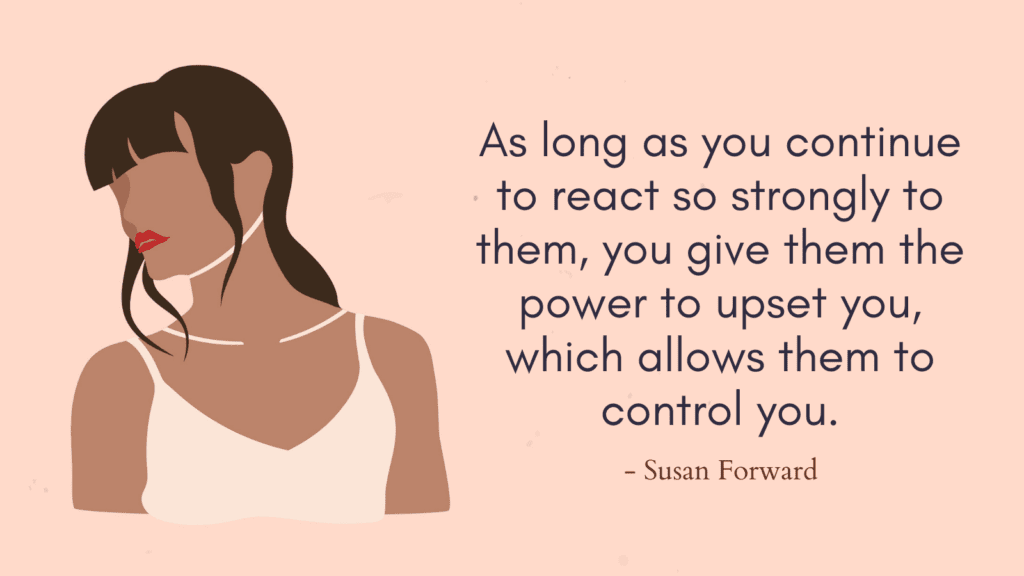In this post, you’ll learn all about what happens when you ignore a gaslighter.
Who Is The Gaslighter?
A gaslighter is someone who engages in gaslighting, which is a manipulative behavior where they attempt to make someone question their own reality, memory, or sanity.
Gaslighting tactics often involve the intentional distortion of facts, manipulation of situations, and consistent denying or invalidating of the victim’s experiences or emotions.
The gaslighter typically seeks to exert power and control over the individual and undermine their confidence and autonomy.
Common Tactics Used By Gaslighters
Gaslighters often employ various tactics to manipulate and control others. Here are some common tactics used by gaslighters:
1. Denial: Gaslighters deny their actions, even when there is evidence to the contrary. They may dismiss or downplay incidents, making the victim question their perception of reality.
2. Blaming and Shifting Responsibility: Gaslighters often shift blame onto the victim, making them feel guilty or responsible for the gaslighter’s behavior. This tactic aims to make the victim doubt themselves and accept false blame or responsibility.
3. Contradiction and Discrediting: Gaslighters may contradict their previous statements or twist events to confuse the victim. They may also discredit the victim’s thoughts, feelings, or experiences, undermining their credibility.
4. Withholding Information: Gaslighters may deliberately withhold information or selectively share details to further manipulate the victim’s understanding of a situation. This can cause confusion and doubt.
5. Minimization and Trivialization: Gaslighters minimize the impact of their actions, downplaying the victim’s feelings or experiences. This invalidation makes the victim question the significance of their own emotions.
6. Gaslighting Through Positive Reinforcement: Gaslighters may also alternate between abusive behavior and kind gestures or praise, creating a cycle of confusion and dependence. This can make it harder for the victim to recognize and break free from the manipulation.
Related: Am I Being Gaslighted Quiz
What Happens When You Ignore A Gaslighter?
Gaslighters thrive on having power and control over their victims, and when this control is undermined by being ignored, it can trigger intense emotional reactions. Here are ten potential reactions that a gaslighter may exhibit:
1. Anger and Frustration
The gaslighter may become angry because they are no longer getting the reaction they desire, frustrated because their tactics are unsuccessful, or both.
2. Increased Manipulation Tactics
When you choose to ignore a gaslighter, their manipulation tactics often escalate in an attempt to regain control over the situation.
They might try different techniques, such as guilt-tripping, blame-shifting, or using silent treatment, to make you feel guilty or doubt yourself.
Related: 10 Signs of Gaslighting (+FREE Worksheets)
3. Intensified Gaslighting Behavior
When you choose to ignore a gaslighter, their behavior tends to intensify as they desperately try to regain control and manipulate your perception of reality.
One way gaslighters may intensify their behavior is by escalating their manipulation techniques. They might twist your words, distort facts, or even fabricate stories to confuse and disorient you further.
Another way gaslighters may escalate their behavior is through passive-aggressive tactics. They might give you the silent treatment, withhold affection, or make subtle jabs at your self-esteem.
4. Persistence and Repeated Attempts
Some gaslighters may persistently try to regain your attention and engage with you.
They might send multiple messages, make constant calls, or show up in person to get a reaction from you.
Related: How To Turn The Tables On A Gaslighter?
5. Provoking a Reaction
Gaslighters may deliberately provoke you to elicit a response.
They might use provocative statements, insults, or emotionally charged situations to make you react and engage with them again.
6. Playing the Victim
Gaslighters may switch to playing the victim as a way to gain sympathy or guilt-trip you into responding.
They might portray themselves as misunderstood or mistreated to manipulate your emotions.
7. Seeking Validation from Others
Some gaslighters may try to seek validation from others by spreading rumors, gossiping, or manipulating mutual acquaintances to create a narrative where they are the ones being ignored or mistreated.
Related: Best 10 Books On Gaslighting
8. Retreat or Withdrawal
In some cases, gaslighters may withdraw or retreat when they realize that their attempts to engage or manipulate you are futile.
They might temporarily give up on their efforts and focus their attention elsewhere.
9. Temporary Change in Behavior
A gaslighter might temporarily alter their behavior, appearing kinder, more understanding, or remorseful to make you believe that they have changed.
This could be a manipulation tactic to lure you back into the cycle of gaslighting.
10. Escalation of Aggressive Behavior
In rare cases, when ignored, a gaslighter may escalate to more aggressive or threatening behavior to regain control over you.
This can include harassment, stalking, or intimidation.
Please note that every individual and situation is unique, so these reactions are not exhaustive and may vary based on the specific circumstances.
It’s important to prioritize your safety and well-being in any interaction with a gaslighter.
Related: The Narcissist’s Prayer Explained

Strategies for Dealing with a Gaslighter
Dealing with a gaslighter can be challenging, but here are some strategies that might help you navigate such situations:
1. Trust Your Perception
Gaslighters try to undermine your perception of reality.
Remind yourself that your thoughts and feelings are valid.
Trust your instincts and maintain confidence in your understanding of the truth.
2. Set Clear Boundaries
Establish and communicate your boundaries with the gaslighter.
Make it clear what behavior is acceptable and what is not.
Maintain consistency in enforcing these boundaries to protect yourself.
Related: How To Set Boundaries With A Narcissist?
3. Seek Support
Reach out to trusted friends, family, or professionals who can provide you with validation and emotional support.
They can help you see through the gaslighting tactics and remind you of your worth.
4. Practice Self-Care
Taking care of your physical and emotional well-being is crucial when dealing with a gaslighter.
Engage in activities that bring you joy and relaxation.
Prioritize self-care routines, such as exercise, healthy eating, sleep, and mindfulness practices.
5. Educate Yourself
Learn about gaslighting techniques and manipulative behavior patterns.
Understanding the dynamics involved can help you recognize and respond to gaslighting more effectively.
Related: How To Deal With A Narcissistic Mother-In-Law?
6. Document Incidents
Keep a record of incidents, conversations, or any evidence that supports your version of events.
This documentation can serve as a reminder of the gaslighter’s tactics and help you maintain clarity.
7. Limit Contact
If possible, create some distance between yourself and the gaslighter.
Minimize or restrict contact as much as you can to reduce their influence on your well-being.
This could involve setting boundaries around communication or considering distancing yourself from toxic relationships.
8. Seek Professional Help
If the gaslighting affects your mental health and well-being significantly, consider consulting a mental health professional.
They can provide guidance, support, and strategies tailored to your specific situation.
Remember, every situation is unique, and not all strategies may be applicable or feasible.
It’s important to prioritize your safety and well-being above all else.
Moving Forward and Healing from Gaslighting
Moving forward and healing from gaslighting can be a gradual but empowering journey. Here are some suggestions to help you in your healing process:
1. Validate Your Experience
Acknowledge and accept that you have experienced gaslighting. Understand that it is not your fault and that you are not alone.
Validating your experience is an essential step toward healing.
Related: 8 Stages Of Healing After Narcissistic Abuse (+FREE Breakup Recovery Worksheets)
2. Practice Self-Compassion
Be kind to yourself and practice self-compassion.
Recognize that you have been through a challenging situation and allow yourself time to heal.
Treat yourself with love, understanding, and patience.
3. Challenge the Gaslighter’s Narratives
Identify the false narratives that the gaslighter has instilled in your mind.
Replace them with positive and realistic beliefs about yourself.
Surround yourself with supportive individuals who can help reinforce these positive beliefs.
4. Engage in Self-Reflection
Take time to reflect on the gaslighting tactics that were employed against you.
Develop an understanding of how they affected your perception of reality.
This self-reflection can help you regain your agency and prevent future manipulation.
Related: Top 10 Journal Prompts For Narcissistic Abuse (+FREE Worksheets)
5. Practice Self-Care
Prioritize your physical and emotional well-being by engaging in self-care practices.
This could involve activities such as exercise, journaling, meditation, spending time in nature, or pursuing hobbies that bring you joy.

Conclusion
Gaslighters thrive on power and control, and when their tactics fail to elicit the desired response from their victims, they may become more persistent and inventive in their methods.
By consistently ignoring these attempts at manipulation, the gaslighter’s behavior may become more extreme as they desperately search for new ways to manipulate and control their victim.
It’s important to remember that ignoring a gaslighter can be challenging, as it requires strength and determination, but doing so can help protect your mental well-being and lessen their hold over you.
Be patient with yourself and seek support when needed.
With time and effort, you can heal from the effects of gaslighting and reclaim your sense of self-worth and control over your life.
FAQ
1. Why do gaslighters engage in this behavior?
Gaslighters engage in this behavior for various reasons, such as a need for control, manipulation, power, or to undermine the self-esteem and confidence of their victims.
It may also stem from their own psychological issues, unresolved trauma, or a learned behavior pattern from their upbringing.
2. Are gaslighters always aware of what they are doing?
Gaslighters may or may not be fully aware of what they are doing.
Some gaslighters employ manipulative tactics consciously and intentionally, while others may engage in these behaviors on an unconscious level, influenced by their own emotional patterns and defense mechanisms.
Regardless, the impact on the victim is significant.
3. Can anyone be a victim of gaslighting?
Yes, anyone can potentially become a victim of gaslighting.
Gaslighting does not discriminate based on age, gender, or background.
However, it is important to remember that not all difficult or abusive relationships involve gaslighting.
The ability to recognize manipulation and set boundaries plays a role in preventing or avoiding becoming a victim.
Related: Top +25 Things Abusers Say To Their Victims
4. Are there different levels or degrees of gaslighting?
Gaslighting can indeed occur at different levels or degrees.
This can range from subtle tactics aimed at sowing doubt or confusion to more severe and prolonged forms of emotional and psychological abuse.
The severity and impact of gaslighting can vary depending on factors such as the intensity, duration, and frequency of the manipulation, as well as the vulnerability and resilience of the victim.
5. Is it possible for a gaslighter to change their behaviors?
While it is challenging for gaslighters to change their behaviors, it is not impossible.
Change requires a genuine willingness on their part to recognize the harm they have caused and to address their own underlying issues.
Personal growth, therapy, and self-reflection can potentially help gaslighters develop insight, empathy, and healthier ways of relating to others. However, lasting change depends on the individual’s motivation and commitment to personal growth.
6. Can therapy be helpful in recovering from gaslighting?
Therapy can be instrumental in helping individuals recover from the effects of gaslighting.
It provides a safe and supportive space for processing the experiences, validating emotions, rebuilding self-esteem, and developing healthy coping strategies.
Therapists trained in trauma-focused therapy or cognitive-behavioral therapy (CBT) can assist individuals in overcoming the psychological impacts of gaslighting and regain their sense of self-worth and clarity.
However, the effectiveness of therapy may vary depending on individual circumstances, the severity of the gaslighting, and the commitment to the therapeutic process.



